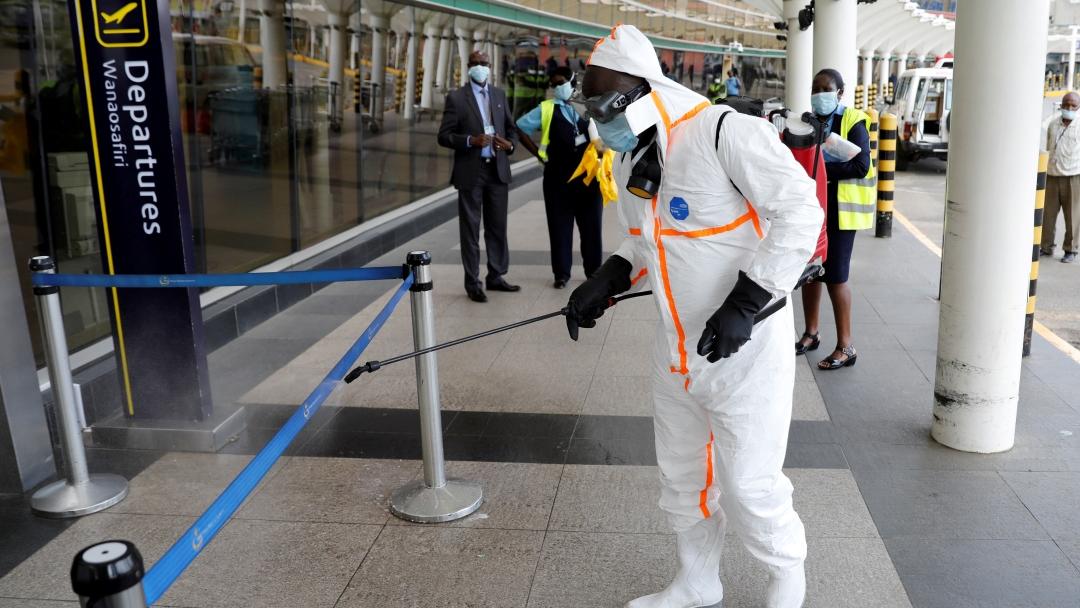WHO fills gaps to fight COVID-19 in countries with weaker health systems, says spokesperson
A health worker sprays disinfectant to prevent an outbreak of the coronavirus disease (COVID-19) at the Jomo Kenyatta International Airport in Nairobi, Kenya, March 24, 2020.
About one-fifth of the world’s population is now under some form of lockdown to help stem the spread of COVID-19, the disease caused by the novel coronavirus.
In Mexico, however, President Andrés Manual López Obrador has yet to issue travel bans or require social distancing. That may affect less-resourced, neighboring countries like Guatemala.
Related: Experts concerned Mexico not taking enough COVID-19 precautions
At the same time, China has lifted the strict travel restrictions in Wuhan and the surrounding Hubei province, where the coronavirus was first identified.
In places like Hong Kong and Singapore, new cases have occurred after restrictions have been lifted, which has left citizens and leaders like to wonder how long lockdowns are needed.
Related: Is South Korea’s approach to containing coronavirus a model?
Today, the World Health Organization said that the world is now “seeing a very large acceleration” in US coronavirus infections and said the US has the potential to become the new epicenter of the global crisis.
Tarik Jasarevic, a WHO spokesperson, spoke with The World’s Marco Werman, about WHO’s biggest concerns right now when it comes to the coronavirus, and where the US registers on their radar at the moment.
Related: COVID-19: The latest from The World
“What we are seeing, over the past couple of weeks, is exactly the acceleration of infections around the world. We know that the epicenter of this outbreak is in Europe right now. So, the epicenter shifted from Asia to Europe and many European countries are dealing really with a big number of newly infected people and health systems are struggling to cope in some countries, such as Italy or Spain,” Jasraevic said.
“At the same time, Asian countries have seen — through very strong public health measures — the reduction in numbers of new cases. So, examples from China tell us that it’s possible to control it.”
Marco Werman: So, US President Donald Trump has expressed enormous frustration with the measures taken so far to contain coronavirus in the US. From what you’ve seen in other parts of the world, how important are the next two to three weeks to getting the containment protocol right?
Tarik Jasarevic: Well, I think what we have seen in other places is exactly that. If you try to go after the virus, you may then be able to isolate only sick people and not try really to quarantine all areas. For example, South Korea was doing extensive testing and contact tracing. So, our message is really the same for everyone. It’s basically: test people, isolate and trace. And that’s the best way.
Obviously, we may need to go into physical distancing, trying to slow down the progression of the virus to give time to health systems to cope with numbers. What we were worried about, from day one, was the arrival of the virus to weaker health systems. And we have been trying to help countries with weaker health systems to get equipped and get trained. Hopefully, countries in sub-Saharan Africa will be able to face this danger in a more prepared way now.
Related: African countries restrict travel in bid to slow spread of coronavirus
So, China is planning to lift travel restrictions in Wuhan, and those were pretty strict travel restrictions, as well as the surrounding Hubei province, where the coronavirus was first identified. Is the WHO concerned about that?
Well, we believe that every country in the world is trying to do the best for their citizens. And there is no blanket recommendation for everyone. It’s not the same thing if your country has just a few identified people with COVID-19, or if you have thousands of people already in the health facilities. And countries really have to assess their situation and try to find appropriate measures. The WHO is providing really general guidelines. We believe — and what we have seen — in China is that they have really taken drastic measures. People have been in their homes for months and in the end, they managed to bring the numbers of new infections almost to zero. So we believe that countries should share experiences — no situation is the same everywhere — but we should really try to learn from one another. This is really time for solidarity.
Related: Pandemic threatens stability, demands coordinated global action, says Susan Rice
As of today, what is the biggest concern of the WHO regarding this pandemic?
It is still — what will happen when the virus arrives in areas with weak health systems. For example, if you look at Africa, there are countries who already experienced a number of outbreaks of different diseases, of measles, of cholera, where there is a big prevalence of HIV/AIDS, where there is malnourishment among the population — how these systems and these populations will face this outbreak. So, we have been trying, from the beginning, to work with them to see where the gaps are and how we can fill them. We have, for example, distributed personal protective equipment to 68 countries. We have distributed laboratory testing kits to 120 countries around the world. We continue to do some trainings. But again, unfortunately, the level of development of the health system is very unequal in this world. And obviously, we are worried about those who have a weaker health system.
This interview has been edited and condensed for clarity.
